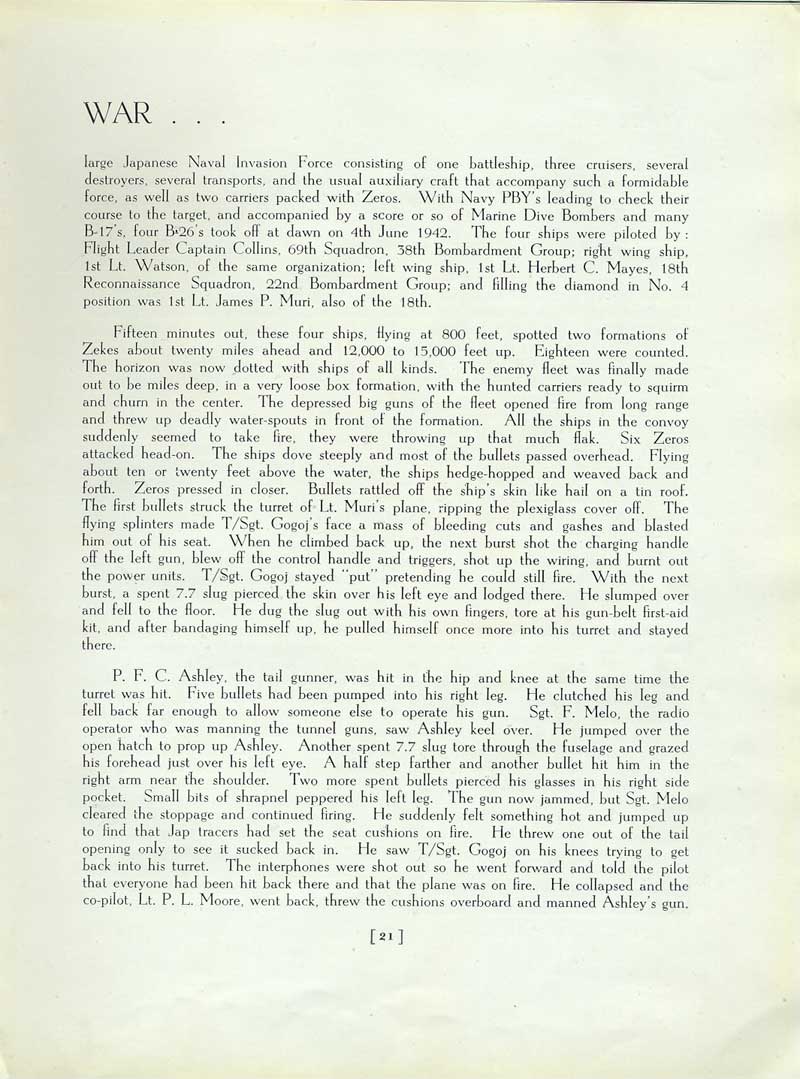
Next page...

| WAR ... large Japanese Naval Invasion Force consisting of one battleship, three cruisers, several destroyers, several transports, and the usual auxiliary craft that accompany such a formidable force, as well as two carriers packed with Zeros. With Navy PBY's leading to check their course to the target, and accompanied by a score or so of Marine Dive Bombers and many B-17's, four B-26's took off at dawn on 4th June 1942. The four ships were piloted by Flight Leader Captain Collins, 69th Squadron, 38th Bombardment Group; right wing ship, 1st Lt. Watson, of the same organization; left wing ship, 1st Lt. Herbert C. Mayes, 18th Reconnaissance Squadron, 22nd Bombardment Group; and filling the diamond in No. 4 position was 1st Lt. James P. Muri, also of the 18th. Fifteen minutes out, these four ships, flying at 800 feet, spotted two formations of Zekes about twenty miles ahead and 12,000 to 15,000 feet up. Eighteen were counted. The horizon was now dotted with ships of all kinds. The enemy fleet was finally made out to be miles deep, in a very loose box formation, with the hunted carriers ready to squirm and churn in the center. The depressed big guns of the fleet opened fire from long range and threw up deadly water-spouts in front of the formation. All the ships in the convoy suddenly seemed to take fire, they were throwing up that much flak. Six Zeros attacked head-on. The ships dove steeply and most of the bullets passed overhead. Flying about ten or twenty feet above the water, the ships hedge-hopped and weaved back and forth. Zeros pressed in closer. Bullets rattled off the ship's skin like hail on a tin roof. The first bullets struck the turret of Lt. Muri's plane, ripping the plexiglass cover off. The flying splinters made T/Sgt. Gogoj's face a mass of bleeding cuts and gashes and blasted him out of his seat. When he climbed back up, the next burst shot the charging handle off the left gun, blew off the control handle and triggers, shot up the wiring, and burnt out the power units. T/Sgt. Gogoj stayed "put" pretending be could still fire. With the next burst, a spent 7.7 slug pierced the skin over his left eye and lodged there. He slumped over and fell to the floor. He dug the slug out with his own fingers, tore at his gun-belt first-aid kit, and after bandaging himself up, he pulled himself once more into his turret and stayed there. P. F. C. Ashley, the tail gunner, was hit in the hip and knee at the same time the turret was hit. Five bullets had been pumped into his right leg. He clutched his leg and fell back far enough to allow someone else to operate his gun. Sgt. F. Melo, the radio operator who was manning the tunnel guns, saw Ashley keel over. He jumped over the open hatch to prop up Ashley. Another spent 7.7 slug tore through the fuselage and grazed his forehead just over his left eye. A half step farther and another bullet hit him in the right arm near the shoulder. Two more spent bullets pierced his glasses in his right side pocket. Small bits of shrapnel peppered his left leg. The gun now jammed, but Sgt. Melo cleared the stoppage and continued firing. He suddenly felt something hot and jumped up to find that Jap tracers had set the seat cushions on fire. He threw one out of the tail opening only to see it sucked back in. He saw T/Sgt. Gogoj on his knees trying to get back into his turret. The interphones were shot out so he went forward and told the pilot that everyone had been hit back there and that the plane was on fire. He collapsed and the co-pilot, Lt. P. L. Moore, went back, threw the cushions overboard and manned Ashley's gun. |